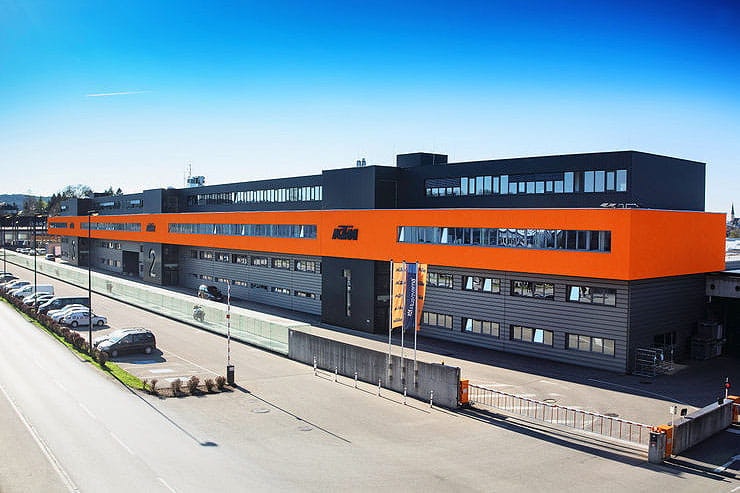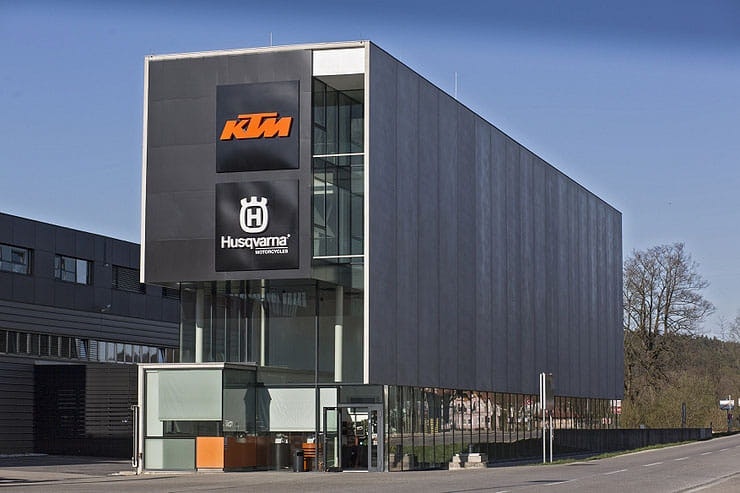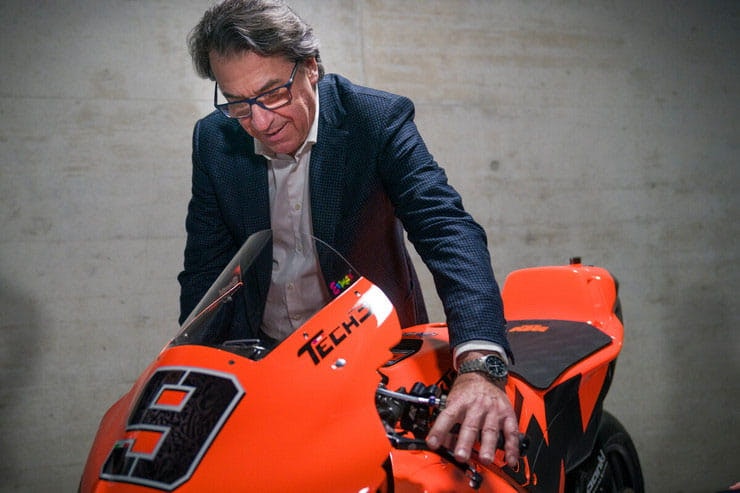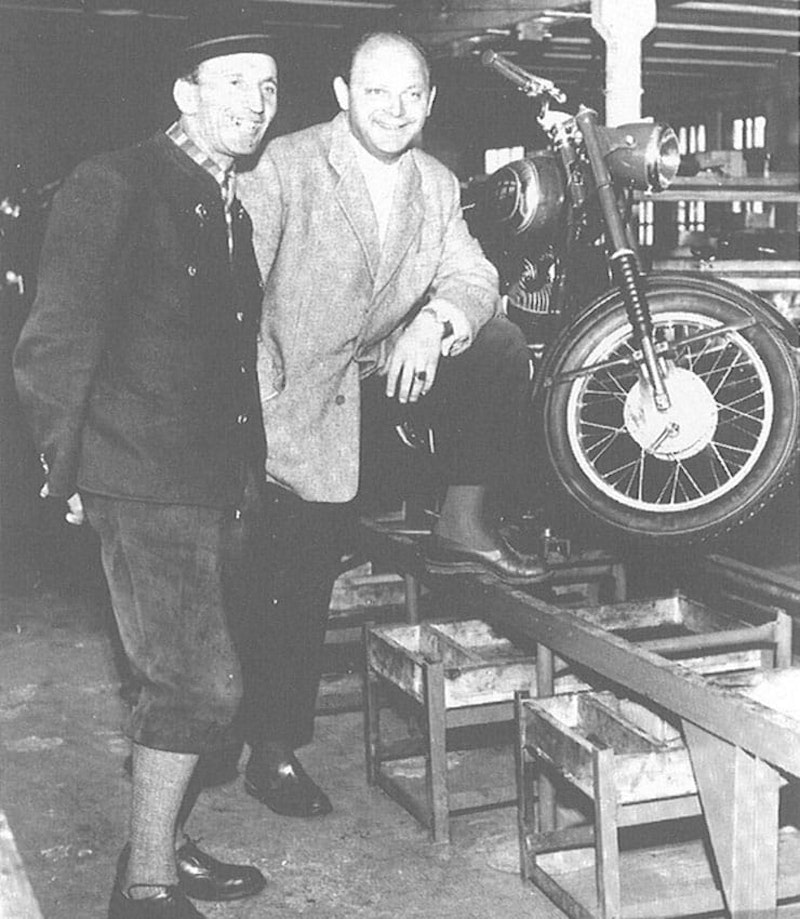Inside the fascinating (and complex) world of KTM
By Ben Purvis
Motorcycle Journalist
21.02.2023
Over the last three decades KTM has been a phenomenon in motorcycling – emerging from little-known dirt bike specialist into a global player with competition success everywhere from the Dakar to MotoGP and ranking as Europe’s biggest motorcycle manufacturer – but in recent years the brand’s reach has expanded even faster with the acquisition of Husqvarna, GasGas and, most recently, a substantial share in MV Agusta.
So how did KTM become the behemoth it is today, and what does the future hold for the brand?
Above: Hans Trunkenpolz and Ernst Kronreif
When did KTM start?
KTM’s history dates back to 1934, when Hans Trunkenpolz set up shop in Mattighofen, Austria, initially repairing cars and motorcycles under the name Kraftfahrzeug Trunkenpolz Mattighofen, but it took nearly two decades before a motorcycle bearing the name would appear. The first was the R100 that reached production in 1953, making 2023 KTM’s 70th anniversary as a motorcycle maker.
The same year, Ernst Kronreif took a major shareholding in the firm, which was renamed Kronreif & Trunkenpolz Mattighofen, the real essence of the ‘KTM’ brand that it retains to this day. However, while there’s still a Trunkenpolz connection in the current iteration of KTM, with Hubert Trunkenpolz as part of the management team, KTM as we know it really started life in the early 1990s.
Having passed to Hans’ son Erich in the 1960s, KTM expanded fast, starting to build bicycles as well as motorcycles, but the firm hit trouble in the 1980s and in 1991 the brand’s ownership was transferred to creditors. They split KTM into four parts, selling the motorcycle-making section – renamed KTM Sportmotorcycle GmbH – in 1992 to Cross Industries, an investment company set up by a young mechanical engineer called Stefan Pierer, who’s overseen KTM’s rise to dominance since.
Above: KTM’s first bike, the R100 of 1953
Who owns KTM?
Today, Cross Industries has morphed into Pierer Industrie, which in turn owns Pierer Mobility AG, the parent to KTM and a host of other brands. Stefan Pierer remains the driving force behind the company’s direction to this day, his own fortunes rising alongside those of KTM. He entered Forbes magazine’s list of the world’s billionaires in 2018 and remains on it today with a $1.2 billion fortune that makes him the tenth wealthiest person in Austria, according to Forbes’ 2022 ranking.
It was under Pierer’s guidance that KTM started to edge further towards street bikes. The Duke 620 was launched in 1994, and four years later work started on the LC8 V-twin engine, a project that would come to fruition in 2003 when the 950 Adventure reached production – making 2023 another anniversary for KTM, marking 20 years of multi-cylinder models. The RC8 superbike appeared 15 years ago in 2008, as did KTM’s first car, the X-Bow, which has expanded into a range of track-focussed machines since then.
In 2007, Indian automotive giant Bajaj joined forces with KTM, buying a 14.5% stake that it would later extend to 46.5%, owned via its Dutch subsidiary, Bajaj Auto International Holdings BV. In 2021, Bajaj swapped its stake in KTM for a share of Pierer Mobility AG, which now owns 98.2% of KTM.
Above: Not just bikes - KTM’s latest X-Bow supercar
What brands are owned by KTM?
Pierer has never been one to miss an opportunity and KTM isn’t the only company he’s snapped up when the right chance has arisen. In 2005, KTM grabbed control of Husaberg, and two years later started a gradual takeover of WP suspension, eventually integrating the company completely with KTM in 2017.
In 2013, a change in heart at BMW – which had bought Husqvarna from Claudio Castiglioni’s MV Agusta Group in 2007 – saw the brand come on the market again, and Pierer was quick to add it to the KTM portfolio. That spelled the end for Husaberg which had been established in 1987 by ex-Husqvarna employees when Castiglioni bought Husky. Since the two brands were reunited under Pierer ownership, there was little sense in keeping them as separate entities.
In 2019, Pierer bought Spanish brand GasGas, adding it to the KTM arm of Pierer Mobility. Today all three brands – KTM, Husqvarna and GasGas – use as many shared parts as possible to keep R&D and production costs down, while retaining their own identities thanks to distinct styling and marketing.
But they’re far from the only companies owned by Pierer Mobility, which also owns four bicycle and e-bicycle makers – Raymon, Felt, Husqvarna E-Bicycles and GasGas Bicycles. Notably, the company doesn’t own KTM Fahrrad, the bicycle brand that sells pushbikes and e-bikes under the KTM name and logo. It’s been a separate entity since way back in 1991 when creditors split up the remains of the original KTM brand, and trademark rights mean Pierer Mobility can’t sell bicycles or e-bicycles wearing the KTM name.
In a third division, Pierer Mobility owns a 50% share in Kiska, the design agency that’s been responsible for the appearance of KTMs for years and now also designs Husqvarna and GasGas motorcycles, as well as working for other motorcycle companies, notably CFMoto, and doing product design for a host of other industries. Alongside Kiska, the design arm of Pierer Mobility also owns 100% of Pierer Innovation, which works on concepts like AI, blockchain, big data and machine learning, and software developer Avocodo.
Who is KTM partnered with?
The roster of companies living under the Pierer roof is just the start of KTM’s wider connections through the bike industry, where you could easily play a game of ‘six stages of separation’ to bring virtually any motorcycle maker into connection with the brand.
The closest, and most recent, addition to the list is MV Agusta. In November, KTM took a 25.1% stake in MV Agusta’s equity, adding much-needed funds to the tune of €30 million to MV’s coffers and opening the door to closer cooperation in the future. At the time, MV CEO Timur Sardarov said: “I am excited about this important agreement, and delighted to welcome KTM AG, Europe’s leading powered two-wheeler manufacturer, into the MV Agusta family. Driven by our shared vision of excellence, the principal goals of our alliance will be the consolidation of our core business and the production of high-performance motorcycles in the premium segment. I am confident that the agreement will strengthen our brand in a complex and challenging marketplace”.
The deal also sees KTM taking over MV’s purchasing and supply chain, creating a new company called MV Agusta Services s.r.l to do so. KTM also takes responsibility for global distribution of MV Agusta bikes, something it had already agreed to do on the North American market but will now take over all over the world.
The stake in MV is still a minority one, but there are already rumours that KTM hopes to take a bigger slice of the company in the years to come. It also raises questions over the longer-term future of MV Agusta’s deal with China’s Qianjiang, parent to the QJMotor and Benelli brands. At the moment, MV has agreed to supply its 1000cc four-cylinder engine to Qianjiang – a prototype QJMotor 1000RR has even been shown to certain people in China – and in return Qianjiang manufactures the small MV Agusta Lucky Explorer 5.5.
The question over the future of MV’s Qianjiang deal comes in part because KTM could fill the same role. It would be all too easy to create a ‘Lucky Explorer’ model based on a KTM 790 Adventure, for instance, but also because KTM has its own close connections with China via Qianjiang’s rival, CFMoto.
In 2022, the joint venture between KTM and CFMoto, which builds KTM’s ‘790’ models including the 790 Duke and 790 Adventure, made 19,000 bikes. It’s projected to scale up to 25,000 in 2023 and has the capacity to build 50,000 annually. The cooperation also sees CFMoto use KTM’s 799cc LC8c parallel twin engine, made in China under licence, in its 800MT adventure bike and the upcoming 800NK naked street bike. KTM’s bigger LC8 V-twin also forms the basis of CFMoto’s 1279cc V-twin, used in the Chinese market 1250TR-G tourer and expected in the upcoming 1250NK naked bike. Meanwhile, Kiska has been responsible for much of CFMoto’s recent styling, and KTM has taken over the distribution and dealer network for CFMoto in much of Europe from January 2023, including the UK and Ireland as well as Austria, Germany, Spain and Switzerland. Hubert Trunkenpolz said: “Pierer Mobility and CFMoto have been in partnership for almost ten years. CFMoto is our production and sales partner for KTM motorbikes in China, and in recent years it has expanded its capacities and supply chains to meet this need. It's also a logical development of our cooperation for us to handle and expand the distribution of CFMOTO motorcycles in selected European markets as a first step.”
Another name that’s connected to KTM, but without any ownership, is famous Mercedes tuning house Brabus. The first motorcycle to bear the Brabus brand name, the 1300R, was launched in 2022, essentially a rebodied version of the KTM Super Duke R.
Above: Brabus 1300R – another string to KTM’s bow
How are Bajaj linked to KTM
India’s Bajaj has been a long-term partner for KTM, owning a substantial stake in the company, which it swapped in 2021 for a share in Pierer Mobility as a whole. Bajaj has built KTM’s small, single-cylinder bikes from 125cc to 390cc since 2011 and the millionth Indian-made KTM rolled off the production line in January 2023.
Now Bajaj is partner on KTM’s development of a 48v electric motorcycle platform – one that’s expected to appear underneath a variety of bikes including the planned KTM E-Duke and Husqvarna E-Pilen, as well as powering Bajaj-branded bikes. However, long-held plans to create a KTM ‘490’ model using a circa-500cc parallel twin engine, developed and built in partnership with Bajaj, appear to have been cancelled. An entire range of ‘490’ models was previewed with blurred-out images, including Adventure, Sports, Duke and Supermoto models, appeared in Pierer documents in 2019, but the plan is not mentioned in the latest presentation document from the company, which refers only to the electric project and plans to ‘further focus on entry-level, 125 to 390cc street motorcycles.’
It’s worth bearing in mind that Bajaj also has relationships with other motorcycle brands, notably Triumph – it’s closely involved in the development and planned manufacturing of the upcoming single-cylinder range of bikes that are expected to be launched under the Triumph name this year. Also, KTM’s increasingly close ties with CFMoto could give the Austrian company the ability to access CFMoto’s all-new 450cc parallel twin, a high-performance design with a 270-degree crankshaft that debuts in this year’s 450SR.
Above: Hubert Trunkenpolz and Stefan Pierer
How big is KTM?
In 2022, Pierer Mobility sold 375,492 motorcycles. That’s 42,611 (13%) more than the previous year, and reflects the sort of spectacular growth that’s become the norm since Pierer rescued KTM from insolvency in the early 90s.
The 2022 figures show KTM is the groups biggest player, accounting for 258,494 sales, followed by Husqvarna on 70,938 and GasGas on 29,691. The remaining 16,369 are electric balance bikes. Add e-bicycles to the mix, and Pierer Mobility’s sales in 2022 rose to 449,971.
The growth is essentially exponential. A decade earlier, in 2012, KTM sales passed 100,000 for the first time, and a decade before that, in 2002, sales first crossed the 50,000 mark.
Growth has been largely constant since Pierer bought KTM, with the exception of a dip in 2008/9 that coincided with the global financial crisis and took a couple of years to recover from. In 2020, the sales dip caused by pandemic-related shutdowns and supply problems was offset by Pierer’s perfectly-timed entry to the e-bicycle market.
Above: KTM’s R&D facility in Austria
Manufacturing and R&D
While other brands – notably Triumph – have shifted production to cheaper locations like Asia, the majority of Pierer’s bikes are still Austrian-made, whether under the KTM, Husqvarna or GasGas name. In 2022, there were around 220,000 bikes made at the Mattighofen headquarters, compared to 150,000 made for the firm by Bajaj in India, 19,000 by CFMoto in China. The GasGas facility in Spain, turned out around 1000 trials bikes. CKD kits are also assembled in Columbia, Brazil, Argentina and the Philippines.
KTM’s main R&D also takes place in Mattighofen, where 750 of the company’s 1200 research and development employees are based (around a fifth of all Pierer Mobility employees are in R&D). In 2022, the firm put €161 million into R&D, up €30 million since 2021, and the company puts around 9% of its revenues back into R&D each year.
Above: Husqvarna E-Pilen is part of the firm’s electric plan for the future
What lies in the future for KTM?
Although KTM was a market leader in electric bikes – the Freeride E hit the market back in 2011 and the current Freeride E-XC sits alongside two electric kids’ crossers and a pair of electric balance bikes – but the company isn’t single-mindedly committed to battery power.
Indeed, Stefan Pierer remains sceptical about the potential for battery powered bikes when it comes to higher performance and longer-range machines, and as a result KTM’s development strategy is two-pronged.
For lower-performance bikes, up to the equivalent of around 250cc in combustion engine terms, KTM is developing, with Bajaj, a 48v electric bike platform that will be used across several models. The firm has already shown the Husqvarna E-Pilen, based on the same chassis that will be used on the next-generation Duke 125 and Duke 390, and a Pierer Mobility presentation a year ago included details of a KTM E-Duke model based on the same components. Both the E-Duke and E-Pilen are due to use a 10kW motor (nominal – the peak power could be higher) with a fixed 5.5kWh battery pack. Meanwhile another model, the Freeride E LV, is planed with a 9kW motor and a swappable 5.5kWh battery, and a launch that’s tentatively scheduled for this year.
In the same report, the firm explained plans to become the global leader in electric bikes from 250W to 15kW (0.335hp to 20hp). KTM is also a core member of the European Swappable Battery Motorcycle Consortium, attempting to standardise an open specification for batteries that can be used across multiple different brands and models, opening the door to a widespread network of battery-swap stations and eliminating ‘range anxiety’.
However, for higher performance bikes KTM and its sister companies are committed to the combustion engine for the foreseeable future. In early 2022, Pierer told SpeedWeek’s Gunther Wiesinger: “We can drive with combustion engines forever. Electromobility is nonsense that is pushed by scientifically uneducated politicians. For a MotoGP bike doing a race distance today on 20 litres of fuel you would need a 500kg battery to achieve comparable performance and range and create the same energy density.”
The solution, according to Pierer, is e-fuels – replacements for petrol that can be used not only for future bikes but to make existing motorcycles carbon-neutral as well. Pierer Mobility’s latest company presentation explains: “For vehicles as of 250ccm, with higher performance and distance requirements, electrification – apart from a few niche products – is not a suitable mass alternative,” citing “lack of energy density” as the problem for batteries. As a result, the firm is putting R&D into e-fuels as well as electric power and expects its future product range to accommodate both types of drivetrain.
While KTM is alone in competing in all three classes of MotoGP, including fielding bikes under GasGas and CFMoto branding, Stefan Pierer has long been against the current trend for ultra-powerful race-replicas on the road. KTM’s sports bike range currently stops at the RC390, although an ‘RC990’ using the next-generation parallel twin Duke chassis and engine as its basis is under development, but like the rest of KTM’s range its focus is more likely to be on low weight than high power. In recent years, declining superbike sales indicate that when KTM cancelled the RC8 – the firm’s one and only effort in the class, and not a bad one at that – in 2015, Pierer was again ahead of the game. Although a track-only, customer version of the RC16 MotoGP bike was planned, that project appears to have been dropped, and there’s no indication that KTM will return to that part of the market.



